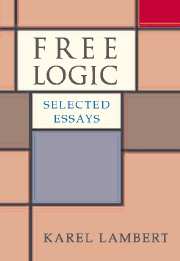Book contents
- Frontmatter
- Contents
- Introduction
- 1 Russell's Version of the Theory of Definite Descriptions
- 2 Existential Import, ‘E!’ and ‘The’
- 3 The Reduction of Two Paradoxes and the Significance Thereof
- 4 The Hilbert-Bernays Theory of Definite Descriptions
- 5 Foundations of the Hierarchy of Positive Free Definite Description Theories
- 6 Predication and Extensionality
- 7 Nonextensionality
- 8 The Philosophical Foundations of Free Logic
- 9 Logical Truth and Microphysics
4 - The Hilbert-Bernays Theory of Definite Descriptions
Published online by Cambridge University Press: 05 June 2012
- Frontmatter
- Contents
- Introduction
- 1 Russell's Version of the Theory of Definite Descriptions
- 2 Existential Import, ‘E!’ and ‘The’
- 3 The Reduction of Two Paradoxes and the Significance Thereof
- 4 The Hilbert-Bernays Theory of Definite Descriptions
- 5 Foundations of the Hierarchy of Positive Free Definite Description Theories
- 6 Predication and Extensionality
- 7 Nonextensionality
- 8 The Philosophical Foundations of Free Logic
- 9 Logical Truth and Microphysics
Summary
INTRODUCTION
The theory of definite descriptions developed by David Hilbert and Paul Bernays has original and revised versions. The original, and most distinctive version (hereafter H-BTDD), received its most explicit statement in the first edition of their treatise on the foundations of mathematics. The account that follows relies primarily on this source. This version of the theory is briefly discussed by Rudolf Carnap, and more fully but informally by G. T. Kneebone and Stephen Kleene (among others). The later theory was Fregeian in spirit, and thus is not distinctive. Moreover, newer versions of the theory (hereafter Neo-HBTDD theories), though more in the spirit of the original theory, converge on but cannot be identified with that species called free definite description theory.
Given its essentially mathematical goal H-BTDD might be thought to be of limited interest outside logic where the canons of reasoning in any discipline are of concern. But caution in this regard is dictated by the fact that there are modifications of H-BTDD where the goal, in part at least, is to provide a treatment of definite descriptions more in keeping with the needs of general philosophy. Moreover, inspired by many of Russell's remarks about (logically proper) names, it is hard to resist to thinking of H-BTDD as a theory of (logically proper) definite descriptions.
Hilbert and Bernays note that it is often convenient to introduce into a piece of mathematical reasoning about a specific mathematical object – for instance, a number, a function or a set – an expression referring to that object by means of some uniquely identifying phrase.
Information
- Type
- Chapter
- Information
- Free LogicSelected Essays, pp. 44 - 68Publisher: Cambridge University PressPrint publication year: 2002
